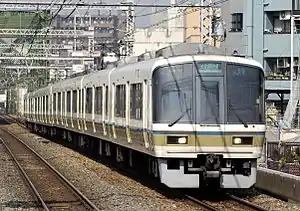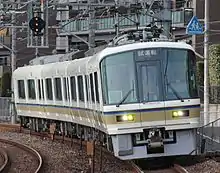221 series
The 221 series (221系, 221-kei) is a suburban electric multiple unit (EMU) train type operated by West Japan Railway Company (JR-West) in the Kansai Region of Japan since March 1989.[1][2]
| 221 series | |
|---|---|
 A 221 series formation in March 2008 | |
| Manufacturer | JR-West Gotō Works, JR-West Takatori Works, Hitachi, Kawasaki Heavy Industries, Kinki Sharyo |
| Built at | Kobe, Yonago, Kudamatsu, Higashiōsaka |
| Family name | Amenity Liner |
| Replaced | 113 series, 117 series, 201 series |
| Constructed | 1989–1992 |
| Entered service | March 1989 |
| Refurbished | 2012–2020 |
| Number built | 474 vehicles |
| Number in service | 474 vehicles |
| Formation | 2/4/6/8 cars per trainset |
| Operator(s) | JR-West |
| Depot(s) | Aboshi, Nara, Kyoto |
| Line(s) served | Tōkaidō Main Line, Sanyō Main Line, Hokuriku Main Line, Kosei Line, Akō Line, Bantan Line, San'in Main Line, Osaka Loop Line, Osaka Higashi Line, Nara Line, Yamatoji Line, Wakayama Line, Sakurai Line |
| Specifications | |
| Car body construction | Steel |
| Car length | 20,000 mm (65 ft 7 in) |
| Width | 2,950 mm (9 ft 8 in) |
| Doors | 3 pairs per side |
| Maximum speed | 120 km/h (75 mph) |
| Traction system | Resistor control + field system superimposed field excitation control |
| Traction motors | MT61 |
| Electric system(s) | 1,500 V DC overhead line |
| Current collection method | WPS27 scissors-type pantograph |
| Braking system(s) | Regenerative brake, electronically controlled pneumatic brakes, snow-resistant brake |
| Safety system(s) | ATS-P, ATS-SW |
| Coupling system | Shibata-Type |
| Multiple working | 223/225 series |
| Track gauge | 1,067 mm (3 ft 6 in) |
Operations
- Tōkaidō Main Line (Biwako Line, JR Kyoto Line, JR Kobe Line) (Maibara - Kōbe, until 2023)
- Sanyō Main Line (JR Kobe Line) (Kōbe - Kamigōri, until 2023)
- Hokuriku Main Line (Biwako Line) (Nagahama - Maibara, until 2023)
- Kosei Line (Yamashina - Ōmi-Imazu, until 2023)
- Osaka Loop Line (only on Rapid services)
- Kansai Main Line (Yamatoji Line) (Kamo - JR Namba)
- Nara Line
- Sakurai Line (Manyō-Mahoroba Line)
- Wakayama Line (Ōji - Gojō)
- Akō Line (Aioi - Banshū-Akō, until 2023)
- Sanin Main Line (Sagano Line) (Kyoto - Fukuchiyama)
- Bantan Line (Himeji - Teramae, until 2023)
- Osaka Higashi Line (from 2020)
Formations
As of 1 October 2012, the fleet consisted of 474 vehicles, formed as 2-, 4-, 6-, and 8-car sets, based at Kyoto, Nara, and Aboshi depots.[3]
8-car sets (A prefix)
| Car No. | 1 | 2 | 3 | 4 | 5 | 6 | 7 | 8 |
|---|---|---|---|---|---|---|---|---|
| Designation | Tc | T' | M1 | T' | M1 | T | M' | Mc |
| Numbering | KuHa 221 | SaHa 220 | MoHa 220 | SaHa 220 | MoHa 220 | SaHa 221 | MoHa 221 | KuMoHa 221 |
6-car sets (B prefix)
| Car No. | 1 | 2 | 3 | 4 | 5 | 6 |
|---|---|---|---|---|---|---|
| Designation | Tc | T' | M1 | T | M' | Mc |
| Numbering | KuHa 221 | SaHa 220 | MoHa 220 | SaHa 221 | MoHa 221 | KuMoHa 221 |
4-car sets (C prefix)
| Car No. | 1 | 2 | 3 | 4 |
|---|---|---|---|---|
| Designation | Tc | T | M' | Mc |
| Numbering | KuHa 221 | SaHa 221 | MoHa 221 | KuMoHa 221 |
8-car sets (NB prefix)
| Car No. | 1 | 2 | 3 | 4 | 5 | 6 | 7 | 8 |
|---|---|---|---|---|---|---|---|---|
| Designation | Tc | T' | M1 | T' | M1 | T | M' | Mc |
| Numbering | KuHa 221 | SaHa 220 | MoHa 220 | SaHa 220 | MoHa 220 | SaHa 221 | MoHa 221 | KuMoHa 221 |
6-car sets (NC prefix)
| Car No. | 1 | 2 | 3 | 4 | 5 | 6 |
|---|---|---|---|---|---|---|
| Designation | Tc | T' | M1 | T | M' | Mc |
| Numbering | KuHa 221 | SaHa 220 | MoHa 220 | SaHa 221 | MoHa 221 | KuMoHa 221 |
4-car sets (NA prefix)
| Car No. | 1 | 2 | 3 | 4 |
|---|---|---|---|---|
| Designation | Tc | T | M' | Mc |
| Numbering | KuHa 221 | SaHa 221 | MoHa 221 | KuMoHa 221 |
| Designation | Tc' | M1 | T | Mc1 |
| Numbering | KuHa 220 | MoHa 220 | SaHa 220 | KuMoHa 220 |
2-car sets
| Car No. | 1 | 2 |
|---|---|---|
| Designation | Tc' | Mc1 |
| Numbering | KuHa 220 | KuMoHa 220 |
4-car sets (K prefix)
| Car No. | 1 | 2 | 3 | 4 |
|---|---|---|---|---|
| Designation | Tc | T | M' | Mc |
| Numbering | KuHa 221 | SaHa 221 | MoHa 221 | KuMoHa 221 |
The KuMoHa 221 cars in some formations are equipped with a second de-icing pantograph.
Interior
Seating is arranged as 2+2 abreast transverse flip-over seats.
 Original interior style in May 2009
Original interior style in May 2009.jpg.webp) Interior of a refurbished train
Interior of a refurbished train.jpg.webp) Original LED passenger information display in September 2005
Original LED passenger information display in September 2005.jpg.webp) LED passenger information display of a refurbished train in October 2014
LED passenger information display of a refurbished train in October 2014.jpg.webp) Wheelchair-accessible toilet of a refurbished train
Wheelchair-accessible toilet of a refurbished train
History
The first 221 series trains were introduced from the start of the revised timetable in March 1989.[2]
The 221 series received the Laurel Prize in 1990.[4]
Refurbishment

From December 2012, a programme of refurbishment started, which will ultimately cover the entire fleet of 474 vehicles.[5] Interior improvements include new universal access toilets, provision of wheelchair spaces, and flip-up seating next to the doorways.[5] The first refurbished set, 4-car set K12, was returned to revenue service on 11 January 2013.[6]
References
| Wikimedia Commons has media related to 221 series. |
- Haraguchi, Takayuki (2009). Jr全車両: ビジュアル決定版 Encyclopedia of JR's Railway Cars: JR全車輌. Japan: Sekai Bunka. p. 79. ISBN 978-4-418-09905-4.
- Jēāru zensharyō handobukku: Rail Magazine 2009 JR全車輌ハンドブック2009 [JR Rolling Stock Handbook 2009]. Japan: Neko Publishing. 2009. pp. 271–272. ISBN 978-4-7770-0836-0.
- Jr電車編成表 2013冬 JR電車編成表 2013冬 [JR EMU Formations - Winter 2013]. Japan: JRR. November 2012. p. 406. ISBN 978-4-330-33112-6.
- ブルーリボン賞・ローレル賞 選定車両一覧 [Blue Ribbon & Laurel Prize Winners List]. jrc.gr.jp (in Japanese). Japan: Japan Railfan Club. 29 May 2012. Archived from the original on 2010-10-26. Retrieved 9 January 2013.
- 221系近郊型電車のリニューアルについて [221 series outer-suburban EMU refurbishment] (Press release) (in Japanese). West Japan Railway Company. 8 January 2013. Retrieved 8 January 2013.
- 221系リニューアル車が営業運転を開始 [Refurbished 221 series in revenue service]. Japan Railfan Magazine Online (in Japanese). Japan: Koyusha Co., Ltd. 13 January 2013. Retrieved 13 January 2013.
